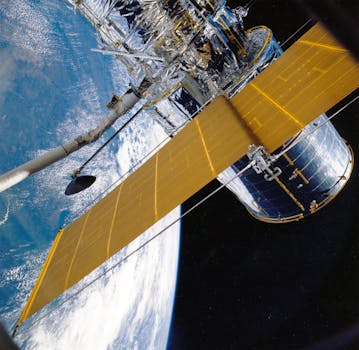Future of Satellites: Revolutionizing Global Communication and Exploration

Future of Satellites: Revolutionizing Global Communication and Exploration
Future of satellites is an exciting and rapidly evolving field that is transforming the way we communicate, navigate, and explore space. With the increasing demand for global connectivity, satellites are playing a vital role in providing internet access, navigation, and communication services to remote and underserved areas.
The future of satellites holds tremendous promise for transforming global communication, navigation, and space exploration. With advancements in technology, satellites are becoming more powerful, efficient, and cost-effective. The development of new satellite constellations, such as OneWeb and Starlink, is expected to provide high-speed internet access to millions of people around the world.
Advancements in Satellite Technology
Recent advancements in satellite technology have led to the development of smaller, lighter, and more efficient satellites. The use of advanced materials and propulsion systems has enabled satellites to be launched into space at a lower cost, making them more accessible to a wider range of organizations and countries. Additionally, the development of reusable launch vehicles, such as SpaceX’s Falcon 9, has significantly reduced the cost of launching satellites into space.
The use of artificial intelligence and machine learning is also transforming the satellite industry. Satellites are being equipped with AI-powered systems that enable them to autonomously navigate, communicate, and make decisions in real-time. This is enabling satellites to be more efficient, reliable, and adaptable to changing conditions in space.
Applications of Satellites
Satellites have a wide range of applications, including communication, navigation, weather forecasting, and Earth observation. Satellites are used to provide internet access, telephone services, and television broadcasting to remote and underserved areas. They are also used for navigation, providing location information and timing signals to GPS receivers on the ground.
Satellites are also used for weather forecasting, providing images and data on cloud patterns, precipitation, and other weather phenomena. They are also used for Earth observation, providing data on the health of the planet, including deforestation, ocean currents, and climate change.
Challenges and Opportunities
Despite the many advancements in satellite technology, there are still several challenges that need to be addressed. One of the major challenges is the issue of space debris, which poses a significant risk to the safety of satellites and other space-based assets. There is also a need for more efficient and sustainable launch systems, as well as more effective ways to manage and regulate the increasingly crowded orbital environment.
However, the future of satellites also presents many opportunities for innovation and growth. The development of new satellite constellations and the increasing demand for global connectivity are driving investment and innovation in the satellite industry. The use of satellites for Earth observation and weather forecasting is also providing new insights and data on the health of the planet, enabling more effective decision-making and policy development.






